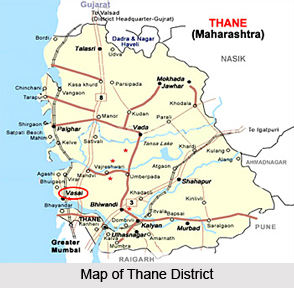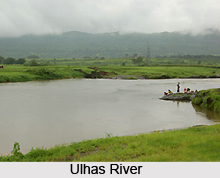 Thane District is an administrative district of Maharashtra. It constitutes a part of North Konkan Region, which lies between the Sahyadri hills in the east and the Arabian Sea in the west. It has coastal line of about 113 kms. District head quarter Thane is about 25 kms from Chhatrapati Shivaji International Airport and 35 kms from Mumbai City. The total geographical area of Thane District is 9558 sq kms which is around 3.11 percent of the total area of the state. In Thane District, there are around 4518 Primary Schools, nearly 937 Secondary Schools, 189 Higher Education Institutes and around 72 Adult Education Adivasi Ashram Schools.
Thane District is an administrative district of Maharashtra. It constitutes a part of North Konkan Region, which lies between the Sahyadri hills in the east and the Arabian Sea in the west. It has coastal line of about 113 kms. District head quarter Thane is about 25 kms from Chhatrapati Shivaji International Airport and 35 kms from Mumbai City. The total geographical area of Thane District is 9558 sq kms which is around 3.11 percent of the total area of the state. In Thane District, there are around 4518 Primary Schools, nearly 937 Secondary Schools, 189 Higher Education Institutes and around 72 Adult Education Adivasi Ashram Schools.
Location of Thane District
Thane District lies between 18 degree 42 minutes and 20 degree 20 minutes north latitudes and 72 degree 45 minutes to 73 degree 48 minutes east longitudes in eastern part of the state. Thane District has triangular shape. Pune District and Ahmadnagar district lie on the East. Nashik district is on the east and north-east, Gujarat and centrally administrated areas of Dadar and Nagar Haveli on its north, Arabian Sea forms the north-west boundary; while Mumbai and Suburban Mumbai districts lie on the south.
History of Thane District
 History of Thane District can be divided into four major periods, the early Hindu period partly mythic and partly historic, coming down to about 1300 AD and properly called Ancient period; the Muslim period lasting from 1300 to 1660 AD, the Maratha period from 1660 to 1800 AD; and the British period since 1880. From pre-historic times the Thane coast has had relation with land beyond the Indian Ocean. Thane District forms part of North Konkan also called Aprant (The western end) later known as Puri-Konkan after its capital Puri. The earliest known fact in the history of Thane coast and incidentally of Apranta belongs to engraving of Ashoka edicts. The Shilharas ruled over North Konkan for move than 400 years. During the Mughal period, Turk rulers had destroyed many temples and Churches of the region. Under the strong rule of Muhammad Bin Tughlaq the Mughal`s maintained their supremacy in north Konkan. Portuguese history would be incomplete without the mention of Vasai. The Portuguese power passed into the hands of Maratha after a long siege by Chimaji Appa, brother of Peshwa Bajirao I. For about sixty-four years, from 1739 to 1802 Vasai remained under the Maratha finally, in 1802 by the Treaty of Vasai it became a British possession and in 1818 it was incorporated in the Bombay Presidency. Under the British rule the trade of the district had developed tremendously.
History of Thane District can be divided into four major periods, the early Hindu period partly mythic and partly historic, coming down to about 1300 AD and properly called Ancient period; the Muslim period lasting from 1300 to 1660 AD, the Maratha period from 1660 to 1800 AD; and the British period since 1880. From pre-historic times the Thane coast has had relation with land beyond the Indian Ocean. Thane District forms part of North Konkan also called Aprant (The western end) later known as Puri-Konkan after its capital Puri. The earliest known fact in the history of Thane coast and incidentally of Apranta belongs to engraving of Ashoka edicts. The Shilharas ruled over North Konkan for move than 400 years. During the Mughal period, Turk rulers had destroyed many temples and Churches of the region. Under the strong rule of Muhammad Bin Tughlaq the Mughal`s maintained their supremacy in north Konkan. Portuguese history would be incomplete without the mention of Vasai. The Portuguese power passed into the hands of Maratha after a long siege by Chimaji Appa, brother of Peshwa Bajirao I. For about sixty-four years, from 1739 to 1802 Vasai remained under the Maratha finally, in 1802 by the Treaty of Vasai it became a British possession and in 1818 it was incorporated in the Bombay Presidency. Under the British rule the trade of the district had developed tremendously.
Geography of Thane District
Topography of Thane District includes several important physical divisions including Sahyadri hill ranges, forest areas, cultivated lands, and two major rivers. Ulhas River and Vaitarna River are the two main rivers of Thane District. Mainly three types of soils are found in Thane District - regur soil, red soil and brownish black soil. Regur soil, which is found in Dahanu, Palghar, Vasai and Thane tehsils, is fertile and useful for horticulture, paddy cultivation and vegetables. Whereas, red soil which is found in Mokhada, Talasari and some parts of other tehsils on the eastern slopes is useful for growing coarse millets. The third type of soil found in Bhiwandi, Kalyan and Shahapur tehsils is useful, particularly for paddy cultivation. Climate of Thane District is basically tropical. However, the climate of coastal plains differs from the climate on the eastern slopes. July is the rainiest month. Minimum temperature recorded here is 17.5 degree Celsius and maximum recorded temperature is 34.4 degree Celsius. Average annual rainfall is 2,576 mm.
Demography of Thane District
Total population of Thane District as per 2001 Census is 81,31,849, of which rural population is 22,29,376 and urban population is 59,02,473. Male population in the district is 43,77,747 and female population is 37,54,102. Further, total literacy rate according to 2001 Census in Thane District is 80.67 percent, out of which male literacy rate is 87.06 percent and female literacy rate is 73.10 percent.
Administration of Thane District
Thane District has 15 tehsils out of which Shahapur tehsil is the largest in area and Talasari tehsil is the smallest in area. Administration of Thane District includes Municipal Corporations, 9 Municipal Councils, 960 Gram Panchayats, and 61 police stations. Total Panchayat Samitis in Thane District is 13. There are altogether 37 cities and 1,748 villages in Thane District.
Yeoor Hills or Mama Bhanja Hills is a hill station in Thane district. This naturally beautiful and pollution free area attracts lot of people.






